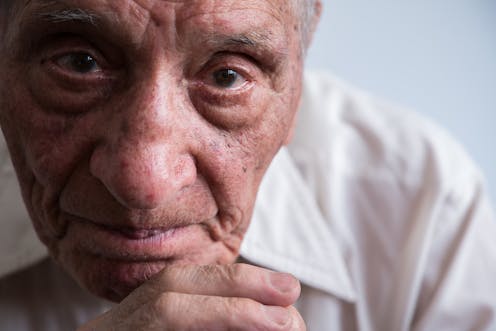Australia's aged care residents are very sick, yet the government doesn't prioritise medical care
- Written by Jane Phillips, Director of IMPACCT, Professor of Palliative Nursing, University of Technology Sydney
 The situation for older Australians isn't what was envisioned when the Aged Care act was introduced in 1997.from shutterstock.com
The situation for older Australians isn't what was envisioned when the Aged Care act was introduced in 1997.from shutterstock.comIt’s been 20 years since the government brought in the Aged Care Act 1997 to deliver a new model of care for older Australians who could no longer live at home and required assistance with daily tasks. The act aimed to facilitate choice and independence for the elderly, and direct services to those with the greatest needs.
But the legislative change also coincided with an era of advanced ageing and more complex needs in our elderly.
People who had previously entered low-level residential aged care (then called hostels), are now cared for in the community. Once they enter aged care, they’re older and sicker than before, and have more complex needs. Since 2008, the number of older Australians admitted to a residential aged care facility has remained steady, but the proportion of people with high-care needs has progressively increased.
Read more: Aussies are getting older, and the health workforce needs training to reflect it
Older and sicker Australians
Currently, around half of people living in aged care have dementia, depression, or another mental health or behavioural condition. The proportion of older people requiring high care for complex needs, which includes assistance with all activities of daily living such as eating and bathing, has quadrupled from 13% in 2009 to 61% in 2016.
When the act was introduced, more emphasis was placed on supporting older people to remain at home for as long as possible. Now, the transition to permanent care only occurs once all options have been exhausted. The needs of the elderly population often outgrow the available community aged care support. This then requires an admission into one of Australia’s 283,000 (subsidised) residential aged care beds. As a result, our aged care facilities are increasingly functioning as hospices for the frail elderly with complex care needs.
The main flaw of the act was to repeal the legal requirement for all aged-care facilities to provide 24-hour registered nursing care to assess and manage resident’s changing clinical needs, wounds and unrelieved pain. So residents have minimal access to this. Too few have access to the necessary help from a geriatric medicine specialist (doctor), psychologist or social worker. And their families have minimal access to psychological and social support, and bereavement follow-up.
Why was the act introduced?
The 1997 act replaced two outdated and confusing 1950s laws to create a single statutory framework for Australian aged care services. It detailed the responsibilities of aged-care operators in relation to quality and compliance. It also empowered the relevant minister to set out principles covering matters such as quality of care, accountability and user rights.
 Older Australians are entering aged care older and sicker than before.from shutterstock.com
Older Australians are entering aged care older and sicker than before.from shutterstock.comThe introduction of the act fuelled a much-needed capital works program funded by low interest bonds from older people entering residential aged care. This was meant to make aged care facilities more home-like, while also meeting care needs.
A major achievement of the act has been the amalgamation of hostels (social care accommodation for older people) and nursing homes (frail aged accommodation with 24-hour nursing care) into a single, user-pays regulated system. Now, people live in one institution, but are classified as having either low-care or high-care needs.
Read more: The shocking state of oral health in our nursing homes
This was to provide older people with an opportunity to “age in place”. So, to have a seamless transition into higher-level care as lower-level physical care needs intensified; and to ensure people living in an aged care facility received all of their care needs in one location.
Major pitfalls of the act
The act’s repeal of the legal requirement for 24-hour nursing care reflected the social model of care underpinning the legislation. The idealistic yet impractical philosophy took the focus away from nursing and medical care. So now, the bulk of personal care is provided by a pool of untrained and unregulated aged-care workers supervised by a very small number of registered nurses.
Registered nurses employed in aged care are central to assessing, planning, monitoring and delivering complex care to older people living in these facilities. But there are too few registered nurses (and they are often managing the facility) so they have limited capacity to ensure the older person’s function, comfort and dignity is optimised, their mobility maintained and dependence minimised.
Read more: Many older people in care die prematurely, and not from natural causes
These skilled nurses also have few opportunities to ensure the resident’s family members receive the appropriate level of psycho-social and spiritual support they often need. Primarily because they’re dependent on the unskilled workers alerting them to changes in the resident’s condition or the families concerns.
Aged care facilities lack the clinical infrastructure of our hospitals. So, if a registered nurse is not on duty, there are few people the unskilled care workers can call for timely clinical review.
If the GP can’t be contacted and the registered nurse is not on duty, an ambulance will be called and the frail older person will be transferred to hospital for assessment.
What needs to happen
Numerous inquiries have highlighted the need for a skilled aged-care workforce to ensure older Australians have access to the level and quality of health care they deserve. These health care gaps persist largely because the act’s principles, while possessing the status of law, are not subject to the same parliamentary control and public accountability.
A new nursing skill mix model is urgently required in aged care to address the level of unmet health care needs. At a minimum, the act should be amended to stipulate appropriate staffing requirements for the delivery of direct clinical care, including the presence of at least one registered nurse at all times. As part of the skill mix, a higher ratio of registered nurses and enrolled nurses supported by a team of care workers is required.
Read more: Here’s why we need nurse-resident ratios in aged care homes
The availability of a nurse practitioner, with advanced training and prescribing rights, and a geriatrician to all aged care facilities would do much to improve timely access to medical care. It’s also likely the addition of this tier of health professionals into aged care would reduce the need for unnecessary emergency department presentations. These are often distressing for the resident and their family, as well as being costly to the system.
Unfortunately, the act fails our most vulnerable members of society and their families by not providing them with the skilled nursing, medical and allied health care they require in their last year, weeks or days of life.
Jane Phillips receives funding from relevant external funding organisations, including government-funded, foundation or research council grants. She is affiliated with Palliative Care Nurses Australia and The Australian Council of Nursing.
Professor David Currow received unrestricted research grant from Mundipharma, is an unpaid member of an advisory board for Helsinn Pharmaceuticals, and has consulted Specialist Therapeutics and to Mayne Pharma and received intellectual property payments from Mayne Pharma.
Deborah Parker receives research funding from a range of sources including government. She is affiliated with Palliative Care Nurses Australia, Palliative Care New South Wales, Australian College of Nursing and Australian Association of Gerontology.
Nola Ries ne travaille pas, ne conseille pas, ne possède pas de parts, ne reçoit pas de fonds d'une organisation qui pourrait tirer profit de cet article, et n'a déclaré aucune autre affiliation que son poste universitaire.
Authors: Jane Phillips, Director of IMPACCT, Professor of Palliative Nursing, University of Technology Sydney





